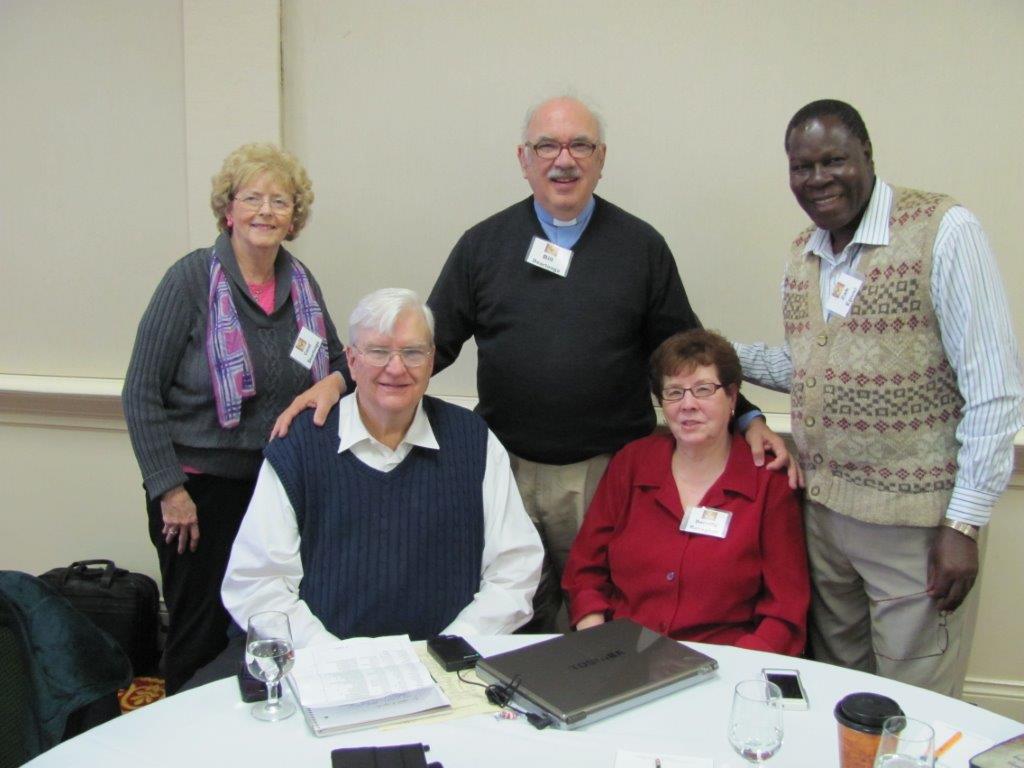The Charismatic Renewal
The Catholics who came included Kevin Ranaghan, a graduate student in theology, and six other students.[19] After a brief lesson on the Gifts of the Spirit by one of the Pentecostal ministers the Catholics asked for the Baptism of in the Spirit. They were encircled by the others and laid hands on for the Baptism. Within minutes, most were speaking in tongues, and all experienced a powerful impartation.

Carolyn and William De Arteaga (standing behind) with Kevin and Dorothy Ranaghan at the Charismatic Leaders Fellowship in 2013. The Ranaghans have been leaders of the Catholic Charismatic renewal since its inception.
A retired Pentecostal missionary present asked the Catholics, “Now that you have received the Holy Spirit, when do you plan to leave the Catholic Church?” The astonished students insisted they would not leave their church. The missionary added, “Then you will lose the Gift of the Spirit.”[20] The missionary’s expectation was that this group of Catholics, like other Catholics he had seen before him, would leave the Catholic Church. Their affirmation to continue within the Catholic Church as Spirit-filled Catholics was the defining moment in launching the Catholic Charismatic Renewal.
This could not have happened a decade earlier. The Catholic council, Vatican II ended in 1965. It began by Pope John XXIII declaring he wished a new breath of freshness to come into the Church. The discussions and documents of Vatican II created an entirely new possibility of ecumenical exchange between Protestants and Catholics. The Catholic Church now called Protestants “separated brethren,” not heretics. Restrictions on Catholics attending Protestant services were eased. The documents of Vatican II, drafted by the Belgium’s Cardinal Suenens (later a major figure in the Catholic charismatic renewal) actually included several paragraphs urging the “charismas” be received by all Catholics. It also encouraged a stronger role of laity in Church life.[21] Thus, persons like Kevin Ranaghans and instructors Keifer and Bourgeois, who had followed the developments of the Council, understood what was happening to them and their students as within the new Catholic openness to the Holy Spirit.
During the weekend of April 7-9 of 1967, about one hundred students and faculty from Duquesne and Notre Dame met for a weekend of prayer and reflection on what had happened to them. All of this was reported favorable in two national Catholic journals, The National Catholic Reporter and Our Sunday Visitor. From then on, the Catholic Charismatic Renewal went on the “fast forward.” The Notre Dame campus became the center of yearly conferences of Catholic charismatics. The second yearly conference in March of 1968 attracted about 150 attendees. The third conference in 1969 brought 450, the forth 1,300, and the fifth in 1971 over 5,000. By then the movement had begun spreading to the Catholic Church in other countries. In 1976 the conference attracted 30,000 participants, and it was decided that this was unwieldy and henceforth the Catholics would attend regional conferences.
The Catholic charismatic renewal had two unique features. First is the absence of any form of anti-intellectualism or fundamentalism that characterized the original Pentecostal movement. The Catholic renewal was birthed amidst two Catholic universities and from the beginning attracted superb theologians and scholars to its ranks. Fr. Kilian McDonnell, who had from the early 1960s studied and dialogued with Protestants and Pentecostals, joined the ranks of the renewal early on. He served to present the case for an orthodox Catholic Pentecostalism to the American bishops, some of whom had some doubts about the movement.[22] Fr. Francis MacNutt, a Dominican priest who had received the baptism of the Spirit at a CFO, began writing about the gifts of healing.[23] Many others could be cited.
Another singular factor of the Catholic charismatics was that it was led by lay leadership that sprang out of Christian “covenant communities.” Two covenant communities in were particularly important for the beginning of the Catholic charismatic renewal: The People of Praise community at Notre Dame and Word of God at Ann Arbor Michigan.[24]
Covenant communities are an attempt to live out the picture given in the book of Acts of the Jewish/Christian community. In general, these communities developed as groups of families, often with attached singles, living in close proximity in order to better share as life of prayer, fellowship, accountability and the education of their children. The covenant communities gave the Catholic renewal a core of “shock troops” to organize, advertise and propagate the renewal with an effectiveness not seen before.
The advantages given to the lay leaders by these communities were not just spiritual encouragement and support, but practical things such as child care when a leader was called to a conference or ministry. The covenant communities supplied the leadership for the “Catholic Renewal Services,” which prepared conferences, including the huge national conferences at Notre Dame, recorded cassette tapes (the new medium of the times), booklets and position papers on the Charismatic renewal to be used by Catholic charismatics all over the nation – and the world. Out of these communities also came the staff of New Covenant magazine, the charismatic monthly for Catholics, and Servant Books, a major publishing house for books on the renewal.
Category: Church History, Summer 2016


